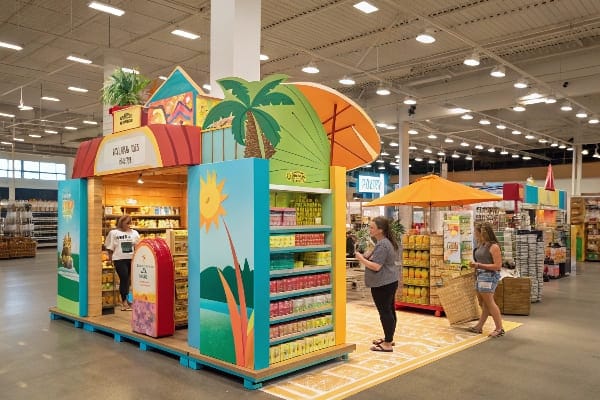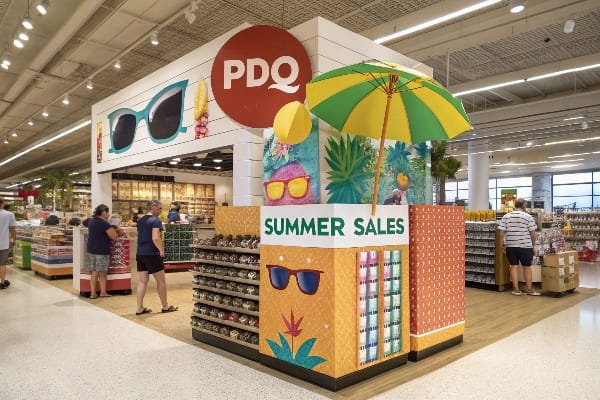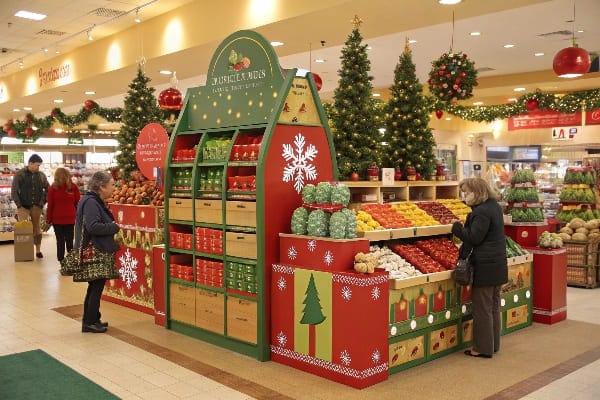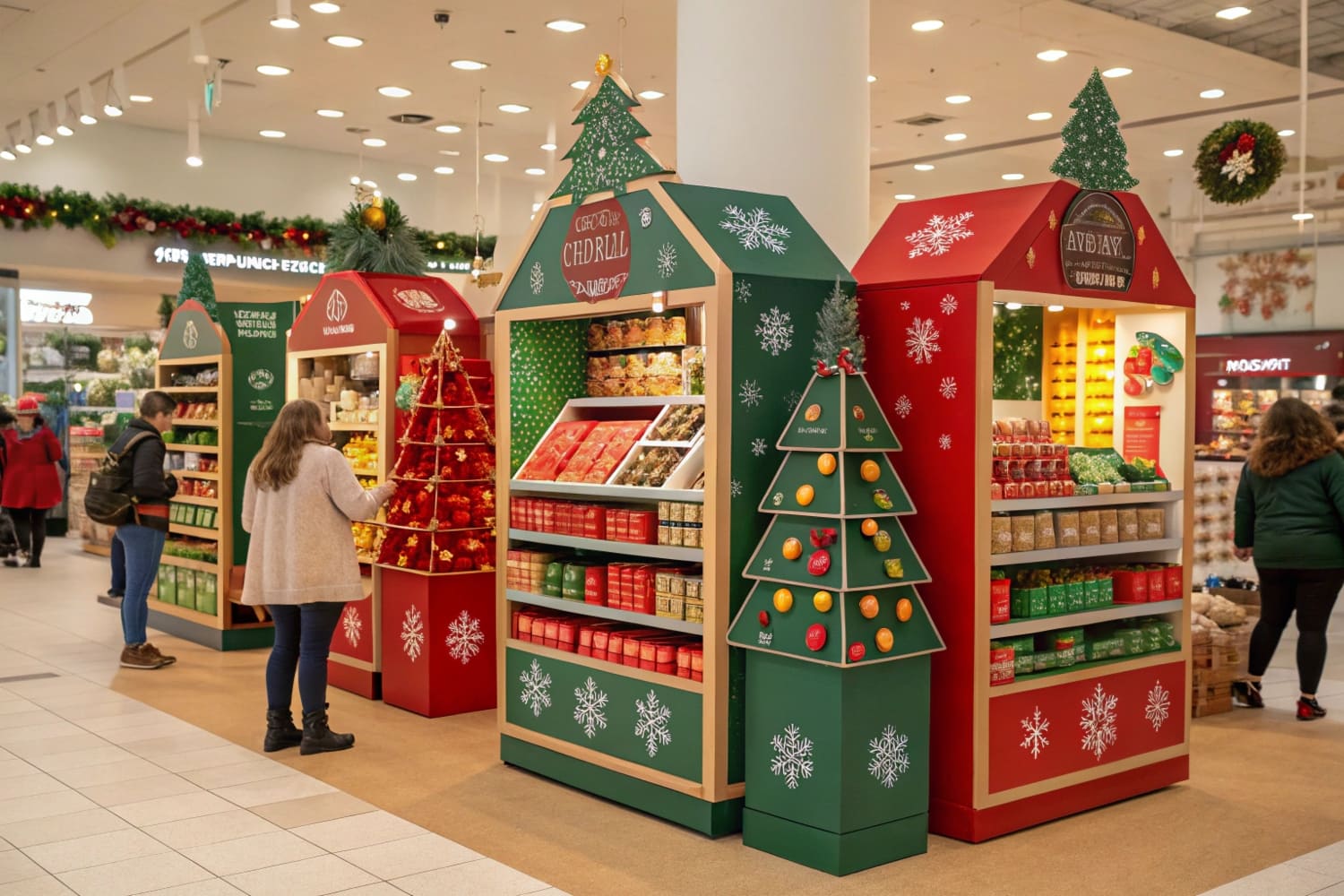Creating an eye-catching seasonal display can boost sales and attract attention. But how do you make sure your display is both engaging and effective? Let’s dive into the world of retail displays and uncover the strategies that can take your seasonal displays to the next level.
Creating a captivating seasonal display is essential to increase customer engagement and drive sales. A well-designed display highlights the theme, enhances the shopping experience, and prompts impulse buys, making it an invaluable tool for any retailer.

Seasonal displays are often the first thing customers notice when entering a store, and they can significantly impact purchasing decisions. A great seasonal display draws in customers by featuring holiday or seasonal-themed items that immediately catch the eye. From Christmas to Halloween, a thoughtfully designed display can communicate your brand’s message, attract foot traffic, and increase sales. But how do you make sure your seasonal display stands out?
How can creating an attractive product display help the retailer?
Product displays are powerful tools for retailers. When done correctly, they help products stand out and engage potential buyers. But what exactly makes an attractive display so impactful? It all comes down to presentation, accessibility, and atmosphere.
An attractive product display helps retailers increase visibility, create a lasting impression, and boost sales by attracting attention to key products. A well-crafted display encourages customers to explore, engage, and ultimately make a purchase.

An effective product display1 should highlight the items in a way that makes them irresistible to potential customers. This means considering factors like layout, color schemes, and the materials used for the display. A well-designed display doesn’t just showcase the product; it tells a story, evokes emotion, and taps into the customer’s needs or desires. This is especially true when the products tie into seasonal trends2 or themes.
The best displays often incorporate a variety of visual elements3, including signage, lighting, and props that help emphasize the products. For example, a fall-themed display might feature pumpkins and autumn leaves as props, combined with warm lighting to create a cozy, inviting atmosphere.
What is the best way to display merchandise?
Effective merchandise displays are key to making sure that products are seen and appreciated. But how do you know which display method works best? Should you go for a wall display, a table setup, or something more interactive?
The best way to display merchandise depends on the type of products being showcased and the space available. A well-organized, clear display that uses props, lighting, and strategic placement can enhance product visibility and appeal.

When designing a merchandise display4, it’s important to keep the flow of the store in mind. A cluttered or overly complicated display can confuse customers, while a clean, organized setup invites them to explore. One great way to approach this is by focusing on creating a focal point5. For example, place your featured products in the center of the display, surrounded by complementary items that enhance the product’s features.
Another tip is to think about the height and depth of the display6. If the display is too low or high, it may be overlooked by customers. Position your display at an eye-catching level, with key items positioned at the front for easy access.
What makes an effective display?
Creating an effective display goes beyond just slapping products on a shelf. It requires a deep understanding of the customer’s psychology and a keen eye for detail. So, what exactly makes a display effective?
An effective display combines creativity, organization, and an understanding of customer behavior. It should clearly highlight the product, communicate its value, and create an experience that resonates with the target audience.

An effective display involves several key elements. First, it should be visually appealing7, using colors and designs that resonate with the target audience and the season. For example, a Christmas display might feature red, green, and gold, creating a festive and celebratory atmosphere. A Halloween display, on the other hand, might use dark colors and spooky imagery to invoke a sense of fun and excitement.
Another important aspect is the flow of the display. A good display guides the customer’s eye from one product to the next, creating a natural progression that encourages exploration. Product placement should also highlight the best features and benefits of each item, making it easy for customers to understand why they should make a purchase.
Finally, effective displays create an experience. Think about how the display makes a customer feel. Does it evoke excitement? Does it make them want to linger and explore more? Creating an immersive experience8 can help drive both foot traffic and sales.
What is seasonal display?
Seasonal displays are designed to celebrate specific holidays, seasons, or events, such as Christmas, summer, Halloween, or back-to-school periods. These displays are typically time-sensitive, with a focus on products related to the season or holiday in question. But what makes them so special?
A seasonal display celebrates a specific time of year or event, using themed decorations and products to create excitement and encourage purchases. By tapping into the spirit of the season, these displays create a sense of urgency and exclusivity that motivates customers to buy.

Seasonal displays have a unique ability to tap into customers’ emotions, creating a sense of urgency and excitement. During Christmas, for example, customers may feel more inclined to purchase gifts for loved ones, while a summer display might promote outdoor products like grills or beach gear.
The beauty of seasonal displays9 lies in their ability to align with current cultural events, weather, or holidays. By creating a display that resonates with the current mood or excitement around a specific season, retailers can boost customer engagement10 and sales.
Another important factor is timing11. Seasonal displays should go up at the right moment to capture the attention of customers when they are most likely to be in the buying mindset. For instance, starting your Christmas display in early December can ensure your store is ready when customers begin their holiday shopping.
Conclusion
Creating effective seasonal retail displays is essential to driving sales, engaging customers, and enhancing the shopping experience. By carefully considering product placement, design, and seasonal themes, retailers can craft displays that not only catch the eye but also influence purchasing decisions.
Explore this resource to learn how to create product displays that attract customers and boost sales. ↩
Understanding seasonal trends can help you design displays that resonate with customers and enhance their shopping experience. ↩
Discover the key visual elements that can elevate your product displays and make them more appealing to shoppers. ↩
Explore expert tips on creating effective merchandise displays that attract customers and enhance sales. ↩
Learn how to effectively use focal points to draw customer attention and improve product visibility. ↩
Understand the significance of display height and depth in maximizing customer engagement and product accessibility. ↩
Explore this resource to learn how to enhance your display’s visual appeal and attract more customers. ↩
Discover innovative examples of immersive experiences that can elevate your retail displays and engage customers. ↩
Explore how seasonal displays can enhance customer engagement and drive sales in your retail strategy. ↩
Learn effective strategies to boost customer engagement during seasonal promotions and maximize sales. ↩
Understand the significance of timing in setting up seasonal displays to capture customer interest effectively. ↩

